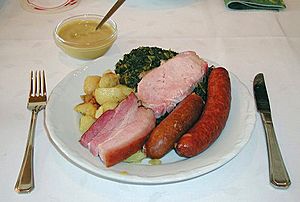Lower Saxon cuisine facts for kids
Lower Saxon cuisine (called Niedersächsische Küche in German) is all about the yummy food traditions from the region of Lower Saxony in northern Germany. Many of these food styles are quite similar, whether you're in Oldenburg, Brunswick, or East Frisia. This food is mostly local and often very filling!
Contents
Vegetables and Side Dishes
The most common side dish in Lower Saxony is the potato. People prepare potatoes in many different ways. A very popular way is Salzkartoffel, which means boiled potatoes.
A very typical vegetable from this area is kale, also known as Grünkohl. In some parts of the region, like Bremen and Brunswick Land, it's called Braunkohl.
Asparagus (Spargel) is a special treat in Lower Saxony. It's grown in many places, including around Burgdorf, Nienburg, Brunswick, and the Lüneburg Heath.
Fish Dishes
In the coastal areas and near big rivers like the Elbe and Weser, you'll find lots of fish dishes. Common fish include plaice, flounder, herring, and mackerel.
Further inland in Lower Saxony, people enjoy trout or eel. For example, eel is very popular around the Steinhuder Meer lake. Just like in many parts of Northern Germany, Fischbrötchen (fish sandwiches) are a favorite snack.
Meat Dishes
Pre-cooked sausage, called Kochwurst, is very popular in the Lüneburg Heath and around Bremen. Local types include Bregenwurst, Kohlwurst, and Pinkelwurst.
Other meat dishes from this area are Knipp, venison, and other game meats. From the Hanover region, two special dishes are Schlachteplatte, which is a plate with different meats, and Calenberger Pfannenschlag. A famous sausage from the region is the Braunschweiger.
In the Gifhorn and Wolfsburg areas, Pottwurst with Sauerkraut is a popular meal in autumn.
Soups and Stews
Soup is often served as a starter. A very popular one is Hochzeitssuppe, which is a meat broth.
Along the North Sea coast, there's a special plant called Stranddreizack or Röhrkohl. It grows in salty meadows near the coast. People prepare it as a thick stew, similar to Grünkohl. Other traditional stews from the coastal region are Steckrübeneintopf (turnip stew) and Birnen, Bohnen und Speck (pears, beans, and bacon).
Desserts and Cakes
For coffee breaks, people often enjoy delicious cakes and desserts. Some favorites include Butterkuchen (butter cake), different kinds of tortes, and Welf pudding. Around the Lüneburg Heath, Buckwheat gateau is a popular cake.
Drinks
Lower Saxony is home to many breweries. You can find them in places like Jever, Einbeck, Celle, Lüneburg, Brunswick, and Hanover.
Two very old types of beer, brewed since the Middle Ages, are Brunswick Mum (Braunschweiger Mumme) and Goslarer Gose.
While most people in Lower Saxony enjoy coffee, there's a very strong tea culture in East Frisia and Friesland. People there drink a lot of tea, some of the highest amounts in the world! Ostfriesland alone drinks about 25% of all the tea consumed in Germany. Tea is a big part of their identity. There's even a tea museum in Norden and annual tea festivals. People in this region usually drink their tea with Kluntjes (rock candy) and thick cream, and they don't stir it.
Many special herbal drinks are made in Lower Saxony. Examples include Heidegeist and Ratzeputz from the Lüneburg Heath, and Schierker Feuerstein and Harzer Grubenlicht from the Harz mountains. The world-famous Jägermeister also comes from this region.
See also
 In Spanish: Gastronomía de Baja Sajonia para niños
In Spanish: Gastronomía de Baja Sajonia para niños



